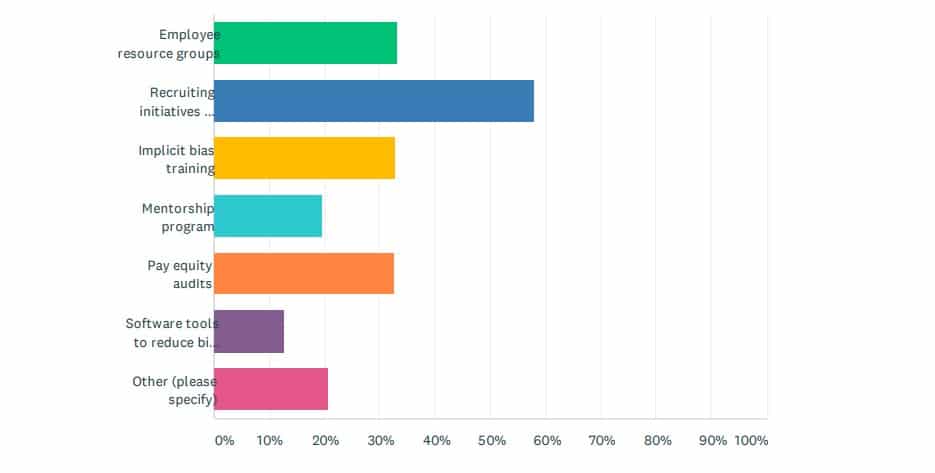Where We Are: Part of the “Improving DE&I for SMBs” Series
Written by Heather Bussing
May 10, 2021

Before we started this series, we wanted to know how small business leaders and HR are doing with diversity, equity, and inclusion in their organizations. So, we did a survey to find out.
One of the difficulties with building and implementing DE&I programs is the people at the top don't always see the problem. Things seem normal. We're doing fine. Why do we need to do all this work that doesn't lead directly to the bottom line?
Another difficulty is that a lot of caring people, who do see problems, are scared we don't understand what to do or how to do it. We're worried we will do it wrong and make things worse. Raise your hand if you have said something you thought was okay but on reflection, it probably offended someone (raises hand). Raise your hand if you have accidentally misgendered someone, if you've seen discriminatory or harassing conduct but weren't sure how to respond, if you've been awkward around a disabled person and not known whether to offer help (hands way up).
It's hard to see worlds we don't experience. But they exist. It takes education, uncomfortable conversations, a willingness to be wrong and make mistakes, and the capacity to listen and have compassion for the experience of others.
While various leaders have said that real change takes time and we've definitely made incremental progress, we are still much longer on time than change. We've been at this since before the civil war. It's been decades since the Civil Rights Act of 1964. And we still have not passed the Equal Rights Amendment, which was introduced in 1972.
But the pandemic caused a lot of things to change fast. And while we are still struggling with many of those changes, we have learned that we can change fast when needed.
On one level, you just commit to doing things differently because it is necessary and the right thing for everyone.
The Survey
Our survey was sent out to Salary.com customers and contacts in December 2020 and received 775-790 responses, depending on the question. We had an additional 108 to 123 who started the survey, answered the demographic questions, then did not complete the substantive survey questions. While we can never know why, the abandon rate is always important to understand. While some got interrupted and never went back, there was a significant number of people who did not want to or felt uncomfortable answering questions about DE&I at their organization.
Of the people who responded, most were HR professionals (59%). We had a few CEO's and compensation professionals (both at almost 6%), recruiters (4%), HR Consultants (almost 4%), diversity officers (almost 2%), finance and sales (each about 1%), some individual employees (almost 7%), and about 10% other, who didn't quite fit into any of our categories.
Of all the respondents, a little over 25% had 50 or fewer employees, about 17% had 51-100, and about 19% had 101-250. 9% had 501- 1000 employees and about 16% had more than 1000 employees. The industries represented were distributed widely with 18% in education, government, and nonprofit, followed by healthcare at almost 10%, business services at about 9%, manufacturing durable goods at 8%, financial services at a little over 6%, construction at almost 5% and a smattering of others at fewer than 4% of respondents.
We asked 5 questions. The first one was:
What DEI initiatives do you currently have in your organization? (Answer all that apply). We had 790 responses


People are understandably working on recruiting first because if you don't have much diversity, that's where to start. Employee resource groups are a good sign because it means there are people working at the organization who are participating. About a third of respondents said they have implicit or unconscious bias training and pay equity audits.
What are your biggest obstacles to having a more diverse workforce? (Answer all that apply) 790 responses


By far, respondents said the biggest obstacle for organizations is finding qualified diverse candidates. Sometimes this is true, and sometimes this is a misperception based on assumptions that it's true.
About 22% said their current culture was the biggest obstacle, 10% said it wasn't a business priority, and 13% said they weren't sure where to start.
Retaining diverse employees is also an important factor. It appears to be easier to bring people in than to keep them, which may have something to do with culture being a problem.
Improving DEI is an important business goal for my organization. (Agree or disagree.) 778 responses


Encouragingly, nearly 49% strongly agreed and almost 30% agreed that DE&I was an important business goal for a total of 79%.
Improving DEI at work is important for human rights (Agree or disagree.) 778 responses


Again, almost 90% either strongly agreed or agreed.
Last, we asked:
How would you rate your organization's DEI efforts to date? 775 responses.


Over 12% said their DE&I efforts to date were great. Another almost 35% said they were good. Seven percent said their organization was not working on DE&I. And a combined 46% said they were doing okay or that their DE&I efforts need work.
This is encouraging, but there is also lots of room for improvement. We'll dig further into these numbers as we discuss how to improve DE&I in your organization.
Click here to read the next blog in the series.
Click here to read the previous blog in the series


Download our white paper to further understand how organizations across the country are using market data, internal analytics, and strategic communication to establish an equitable pay structure.
Insights You Need to Get It Right











